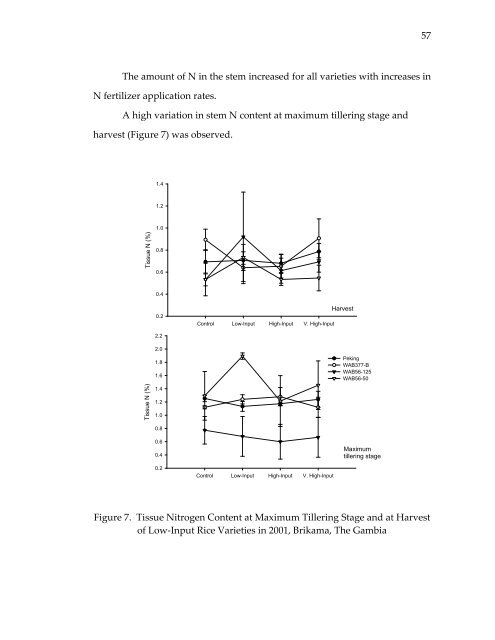- Page 1 and 2:
MANAGEMENT OF RICE PRODUCTION SYSTE
- Page 3 and 4:
MANAGEMENT OF RICE PRODUCTION SYSTE
- Page 5 and 6:
BIOGRAPHICAL SKETCH The author was
- Page 7 and 8:
ACKNOWLEDGMENTS The author is indeb
- Page 9 and 10:
TABLE OF CONTENTS CHAPTER ONE: RICE
- Page 11 and 12:
3.3.2. Effect of Seedling Age at Tr
- Page 13 and 14:
Table 10. Grain Yield from Low‐In
- Page 15 and 16:
Table 28. Soil Sample Analysis at T
- Page 17 and 18:
Table 46. Yield Parameter SRI Ferti
- Page 19 and 20:
Figure 10. Grain Yield at Different
- Page 21 and 22:
context of food security. As there
- Page 23 and 24:
management of soil nutrients and so
- Page 25 and 26: enough fertilizer was available to
- Page 27 and 28: the importation of agricultural inp
- Page 29 and 30: 12000 10000 8000 6000 4000 2000 0 4
- Page 31 and 32: The reason for the decline in The G
- Page 33 and 34: 2.1. Introduction CHAPTER TWO: LOW
- Page 35 and 36: tend to produce moderately higher y
- Page 37 and 38: available nitrogen and phosphorus r
- Page 39 and 40: Table 3. Soil Test Data from Upland
- Page 41 and 42: flood/drought cycle, which is provi
- Page 43 and 44: educed transpiration due to soil wa
- Page 45 and 46: management practices (dry land/irri
- Page 47 and 48: Sta Cruz et al. (1994) identified d
- Page 49 and 50: 2.1.6. Nutrient Dynamics in Tropica
- Page 51 and 52: efficiency (Cassman and Harwood, 19
- Page 53 and 54: (1) Higher mineralization rate in t
- Page 55 and 56: Translocation of N from the vegetat
- Page 57 and 58: NUEp = TDM / NPLANT (3) From equati
- Page 59 and 60: 4) The NuMaSS can be used to predic
- Page 61 and 62: 1. Zero application (Control) 2. Lo
- Page 63 and 64: are averages of duplicated assays a
- Page 65 and 66: show any significant differences be
- Page 67 and 68: Table 8. Low‐Input Upland Rice Tr
- Page 69 and 70: stress conditions that prevailed du
- Page 71 and 72: Fertilizer Level Variety Grain Yiel
- Page 73 and 74: Harvest Index Harvest Index 0.6 0.5
- Page 75: Tissue N (%) Tissue N (%) Tissue N
- Page 79 and 80: NUE(grain) g per g (N) NUE(grain) g
- Page 81 and 82: Necessary inputs for the nitrogen m
- Page 83 and 84: Determining Crop N: The first step
- Page 85 and 86: Hierarchy for NSoil: 1. You will en
- Page 87 and 88: e able to access a value from the d
- Page 89 and 90: Figure 10. Grain Yield at Different
- Page 91 and 92: season, but in the event that major
- Page 93 and 94: In many cases, results did not meet
- Page 95 and 96: 1995 worked with Malagasy farmers a
- Page 97 and 98: 3.1.3. Water Management Water contr
- Page 99 and 100: diffusion from the soil‐water int
- Page 101 and 102: and rewetting of soils as practiced
- Page 103 and 104: 2. SRI will increase rice yields be
- Page 105 and 106: Three sets of rice nurseries were p
- Page 107 and 108: Two rice varieties, IET 3137 and IT
- Page 109 and 110: tillering variety, with plant heigh
- Page 111 and 112: Gambia prefer bigger seedlings beca
- Page 113 and 114: Figure 12. Number of New Roots Re
- Page 115 and 116: Seedling Age 5‐Days 5‐Days 10
- Page 117 and 118: Table 14. SRI vs. Conventional Prac
- Page 119 and 120: The difference in 1000‐grain weig
- Page 121 and 122: Variety Inter Space (cm) ITA 306 IE
- Page 123 and 124: 104 SRI management practice using 3
- Page 125 and 126: fertilizer, but no better panicle f
- Page 127 and 128:
increase in fertilizer application.
- Page 129 and 130:
transplanting urea fertilizer was a
- Page 131 and 132:
112 Applying just compost alone gav
- Page 133 and 134:
submerging the 7‐day old seedling
- Page 135 and 136:
116 An increase in SRI yields in su
- Page 137 and 138:
4.1. General conclusions CHAPTER FO
- Page 139 and 140:
practices are 2 to 3 times higher t
- Page 141 and 142:
application. This study has proven
- Page 143 and 144:
APPENDIX 1: FIELD LAYOUT V. High‐
- Page 145 and 146:
Table 26. Soil Sample Analysis at H
- Page 147 and 148:
Low‐Input 40‐40‐40 APPENDIX 3
- Page 149 and 150:
Table 32. Low‐Input Upland Rice T
- Page 151 and 152:
Low‐Input 40‐40‐40 Table 34.
- Page 153 and 154:
Table 36. Nitrogen‐Use Efficiency
- Page 155 and 156:
Table 38. SRI vs Conventional Pract
- Page 157 and 158:
Table 40. Grain Yield from SRI Prac
- Page 159 and 160:
Fertilizer Level Table 42. SRI Fert
- Page 161 and 162:
Table 44. SRI Fertilizer Management
- Page 163 and 164:
Table 46. Yield Parameters SRI Fert
- Page 165 and 166:
Cabrera, M.L. 1993. Modeling the fl
- Page 167 and 168:
148 Dunsmore, J.R., A.B. Rains, G.D
- Page 169 and 170:
150 Hassink, J., Lebbink, G. and Va
- Page 171 and 172:
152 management in agricultural syst
- Page 173 and 174:
154 Root traits to increase drought
- Page 175 and 176:
156 emission from rice fields: The
- Page 177 and 178:
158 on ammonia volatilization losse
















